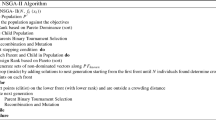Abstract
In the urban traffic system, the traffic congestion is a common phenomena. One main reason of traffic congestion is that the traffic flow and the traffic path is not equilibrium. In this paper, the concept of equilibrium network models include the equilibrium flow and the equilibrium path are firstly initialized and then the mathematical models are formulated and genetic algorithm is designed for solving the proposed equilibrium path model.
Access this chapter
Tax calculation will be finalised at checkout
Purchases are for personal use only
Preview
Unable to display preview. Download preview PDF.
Similar content being viewed by others
References
Randolph, M.J.: Traffic Flow and Capacity. In: Handbook of Transportation Science, pp. 151–183. Randolph W. Hall, New York (1999)
Florian, M.: Network Quilibrium and Pricing. In: Handbook of Transportation Science, pp. 361–394. Randolph W. Hall, New York (1999)
Wang, H.F., Liao, H.: User Equilibrium in Trafficc Assignment Problem with Fuzzy N–A Incidence Matrix. Fuzzy Sets and Systems 107, 245–253 (1999)
Huang, H.J., Li, Z.: CA Multiclass, Multicriteria Logit-Based Traffic Equilibrium Assignment Model Under ATIS. European Journal of Operational Research 160, 560–571 (2006)
Adler, J.L., Blue, V.J.: Toward the Design of Intelligent Traveler Information Systems. Transportation Research C 6, 157–172 (1998)
Adler, J.L., Blue, V.J., Wu, T.L.: Assessing Driver and Network Performance Under Bi-Objective Route Guidance Systems. In: Presented at the 78th Transportation Research Board, Washington, DC (1999)
Dijkstra, E.W.: A Note on Two Problems in Connection with Graphs. Numerical Mathematics 1, 269–271 (1959)
Balachandhrm, V., Randan, C.P.: All-Pairs-Shrotest-Length on Strongly Chordal Graphs. Discrete Applied Mathematics 69, 169–182 (1996)
Pattanamekar, P., Park, D., Rilett, L.R.: Dynamic and Stochastic Shortest Path in Transportation Networks with Two Components of Travel Time Uncertainty. Transportation Research Part C 11, 331–354 (2003)
Azaron, A., Kianfar, F.: Dynamic Shortest Path in Stochastic Dynamic Networks: Ship Routing Problem. European Journal of Operational Research 144, 138–156 (2003)
Frigioni, D., Marchetti-Spaccamela, A.: Fully Dynamic Shortest Paths in Digraphs with Arbitrary Arc Weights. Journal of Algorithms 49, 86–113 (2003)
Davies, C., Lingras, P.: Genetic Algorithms for Routing Shortest Paths in Dynamic and Stochastic Networks. European Journal of Operational Research 144, 27–38 (2003)
Bousono-Calzon, C., Figuiras-Vidal, A.R.: A Bank Hopfield Neural Networks for the Shortest Path Problem. Signal Processing 61, 157–170 (1997)
Miller-Hooks, E.D., Mahmassani, H.S.: Least Possible Time Paths in Stochastic Time-Varying Networks. Computer Operational Research 25, 1107–1125 (1998)
Chen, Y.L., Tang, K.: Minimum Time Paths in a Networs with Mixed Time Constraints. Computer Operational Research 25, 793–805 (1998)
Granat, J., Guerriero, F.: The Interactive Analysis of the Multi-Criteria Shortest Path Problem by the Reference Point Method. European Journal of Operational Research 151, 103–118 (2003)
Modesti, P., Sciomachen, A.: A Utility Measure for Finding Multi-Objective Shortest Paths in Urban Multimodal Transportation Networks. European Journal of Operational Research 111, 495–508 (1998)
Han, Y.: Improved algorithm for all pairs shortest paths. Information Processing Letters 91, 245–250 (2004)
Chen, Y., Yang, H.: Finding the first k shortest paths in a time-window network. Computers & Operations Research 31, 499–513 (2004)
Pettie, S.: A new approach to all-pairs shortest paths on real-weighted graphs. Theoretical Computer Science 312, 47–74 (2004)
Bose, P., Maheshwari, A., Narasimhan, G., et al.: Approximating geometric bottleneck shortest paths. Computational Geometry 29, 233–249 (2004)
Okada, S.: Fuzzy shortest path problems incorporating interactivity among paths. Fuzzy Sets and Systems 142, 335–357 (2004)
Gen, M., Cheng, R.: Genetic Algorithms & Engineering Optimization. Wiley-Interscience Publication, New York (2000)
Godor, I., Harmatos, J., Juttner, A.: Inverse shortest path algorithms in protected UMTS access networks. Computer Communications 28, 765–772 (2005)
Daganzo, C.F.: Reversibility of the time-dependent shortest path problem. Transportation Research Part B 36, 665–668 (2002)
Garey, M., Johnson, D.: Computers and Intractability: A guide to the NP-completeness. W.H. Freeman, New York (1979)
Bondy, J.A., Murty, U.S.R.: Graph Theory with Application. The Macmillan Press Ltd., NYC (1976)
Author information
Authors and Affiliations
Editor information
Rights and permissions
Copyright information
© 2007 Springer-Verlag Berlin Heidelberg
About this paper
Cite this paper
Liu, L., Qian, Y., Yang, T. (2007). The Equilibrium Network Model and Its Genetic Algorithm. In: Huang, DS., Heutte, L., Loog, M. (eds) Advanced Intelligent Computing Theories and Applications. With Aspects of Contemporary Intelligent Computing Techniques. ICIC 2007. Communications in Computer and Information Science, vol 2. Springer, Berlin, Heidelberg. https://doi.org/10.1007/978-3-540-74282-1_31
Download citation
DOI: https://doi.org/10.1007/978-3-540-74282-1_31
Publisher Name: Springer, Berlin, Heidelberg
Print ISBN: 978-3-540-74281-4
Online ISBN: 978-3-540-74282-1
eBook Packages: Computer ScienceComputer Science (R0)




